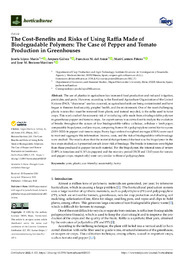Por favor, use este identificador para citar o enlazar este ítem:
https://hdl.handle.net/11000/31852Registro completo de metadatos
| Campo DC | Valor | Lengua/Idioma |
|---|---|---|
| dc.contributor.author | Lopez Marin, Josefa | - |
| dc.contributor.author | Gálvez, Amparo | - |
| dc.contributor.author | del Amor, Francisco Moisés | - |
| dc.contributor.author | Piñero Zapata, María Carmen | - |
| dc.contributor.author | Brotons, Jose M | - |
| dc.contributor.other | Departamentos de la UMH::Estudios Económicos y Financieros | es_ES |
| dc.date.accessioned | 2024-03-27T10:35:54Z | - |
| dc.date.available | 2024-03-27T10:35:54Z | - |
| dc.date.created | 2022-02 | - |
| dc.identifier.citation | Horticulturae V. 8 Issue 2 (2022) | es_ES |
| dc.identifier.issn | 2311-7524 | - |
| dc.identifier.uri | https://hdl.handle.net/11000/31852 | - |
| dc.description.abstract | The use of plastics in agriculture has increased food production and reduced irrigation, pesticides, and pests. However, according to the Food and Agriculture Organization of the United Nations (FAO), “disastrous” use has occurred, as agricultural soils are being contaminated and have begun to threaten food security, peoples’ health, and the environment. One of the most challenging plastic wastes that must be removed from plants, and instead recycled, is the raffia used to tutor crops. This work studied the economic risk of introducing raffia made from a biodegradable polymer in greenhouse pepper and tomato crops. An expert survey was carried out to analyze the evolution of breaks throughout the season of four biodegradable raffias: cellulose, cellulose + kraft paper, compostable biopolymer, and jute-rayon, comparing them with a polypropylene control for two years (2019–2020) in pepper and tomato crops. Fuzzy logic-ordered weighted averages (OWA) were used to treat and aggregate this information. Income, costs, and the risk of biodegradable raffia breakage were studied. The results show that the material that performed the best was the biopolymer in the two crops studied, as it presented a much lower risk of breakage. The breaks in tomatoes were higher than those produced in pepper for each material. For the biopolymer, the internal rates of return (3.49% in tomatoes and 8.14% in peppers) and the recovery period (18.50 and 13.45 years for tomato and pepper crops, respectively) were very similar to those of polypropylene | es_ES |
| dc.format | application/pdf | es_ES |
| dc.format.extent | 19 | es_ES |
| dc.language.iso | eng | es_ES |
| dc.publisher | MDPI | es_ES |
| dc.rights | info:eu-repo/semantics/openAccess | es_ES |
| dc.rights.uri | http://creativecommons.org/licenses/by-nc-nd/4.0/ | * |
| dc.subject | yarn | es_ES |
| dc.subject | plastic | es_ES |
| dc.subject | eco-friendly | es_ES |
| dc.subject | sustainably | es_ES |
| dc.subject | fuzzy | es_ES |
| dc.subject.other | CDU::5 - Ciencias puras y naturales::50 - Generalidades sobre las ciencias puras | es_ES |
| dc.title | The Cost-Benefits and Risks of Using Raffia Made of Biodegradable Polymers: The Case of Pepper and Tomato Production in Greenhouses | es_ES |
| dc.type | info:eu-repo/semantics/article | es_ES |
| dc.relation.publisherversion | https://doi.org/10.3390/horticulturae8020133 | es_ES |

Ver/Abrir:
02 2022 horticulturae-08-00133-v2.pdf
2,39 MB
Adobe PDF
Compartir:
 La licencia se describe como: Atribución-NonComercial-NoDerivada 4.0 Internacional.
La licencia se describe como: Atribución-NonComercial-NoDerivada 4.0 Internacional.
.png)